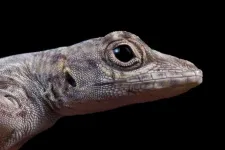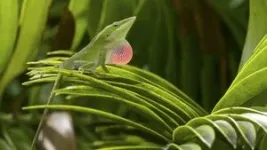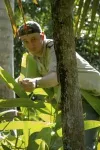(Press-News.org) Charles Darwin said that evolution was constantly happening, causing animals to adapt for survival. But many of his contemporaries disagreed. If evolution is always causing things to change, they asked, then how is it that two fossils from the same species, found in the same location, can look identical despite being 50 million years apart in age?
Everything changed in the past 40 years, when an explosion of evolutionary studies proved that evolution can and does occur rapidly — even from one generation to the next. Evolutionary biologists were thrilled, but the findings reinforced the same paradox: If evolution can happen so fast, then why do most species on Earth continue to appear the same for many millions of years?
This is known as the paradox of stasis, and James Stroud, assistant professor in the School of Biological Sciences at the Georgia Institute of Technology, set out to investigate it. He conducted a long-term study in a community of lizards, measuring how evolution unfolds in the wild across multiple species. In doing so, he may have found the answer to one of evolution’s greatest challenges.
His research was published as the cover story in the Proceedings of the Natural Academy of Sciences.
“We call this a paradox because it doesn’t seem to make any sense,” Stroud said. “The most common explanation is that natural selection is working to stabilize a species’ appearance, with the assumption that an average form will help them survive the best. The problem is, when people do field studies, they almost never find that this kind of ‘stabilizing’ selection actually exists.”
Lassoing Lizards
Stroud set up a field study with four different species of Anolis lizards (anoles) on a small island at the Fairchild Tropical Botanic Gardens in Coral Gables, Florida. He measured natural selection in all four lizard species over five consecutive time periods by catching and monitoring the survival of every lizard on the island.
Stroud and his colleagues searched day and night for lizards. Using long fishing poles with tiny lassos at their tips, they gently captured them by their strong necks, placed them in coolers, and documented the exact branch or stump where they found each lizard.
Back in the lab, Stroud measured the lizards’ heads, legs, feet, weight, and even the stickiness of their toes. After assigning an identifying number to each lizard and marking them with a tiny tag under the skin, the team released the lizards to the same branches where they’d found them. They went out in the following days and weeks to catch the rest of them.
Every six months for three years, Stroud and his team started the process over again. Catching the same lizards, taking measurements, releasing them, and making notes of which lizards survived and which didn’t.
A Picture of Evolution Is Worth a Thousand Lizards
By incorporating data for each time period, Stroud captured the history of every lizard in the community. He then related survival data to the variation in body traits, which allowed him to analyze which body traits were important predictors of survival. Taken together, the analysis painted a picture of how natural selection operated on the community as a whole.
To his surprise, Stroud found that the stabilizing form of natural selection — that which maintains a species’ same, average features — was extremely rare. In fact, natural selection varied massively through time. Some years, lizards with longer legs would survive better, and other years, lizards with shorter legs fared better. For other times, there was no clear pattern at all.
“The most fascinating result is that natural selection was extremely variable through time,” Stroud said. “We often saw that selection would completely flip in direction from one year to the next. When combined into a long-term pattern, however, all this variation effectively canceled itself out: Species remained remarkably similar across the entire time period.”
The findings provided by Stroud’s study had never been seen before. There had never been such insight into how selection works on a community level, and certainly not at this level of detail.
The reason scientists never understood how evolution works on the community level is because long-term studies like Stroud’s are extremely rare. Researchers are unlikely to undertake such projects because of the great amount of work and time required.
“Evolution can and does happen — it’s this ongoing process, but it doesn't necessarily mean things are constantly changing in the long run,” Stroud said. “Now we know that even if animals appear to be staying the same, evolution is still happening.”
According to Stroud, understanding evolution is critical to everything that we want to understand about life on Earth.
“Understanding evolution doesn’t only help us understand the plants and animals around us and how they're distributed across the world,” he said. “It also shows us how life sustains itself in a world dominated by humans.”
There have been very few studies that monitor how evolution unfolds in the wild at long time scales. That, according to Stroud, is why we have a biased view of what evolution is.
“For a very long time, evolutionary biologists have tried to figure out what was behind this paradox of stasis idea,” Stroud said. “What this study shows is that the answer may not be particularly complicated — we just had to conduct a study in the wild for a long enough time to figure it out.”
Citation: Stroud, J.T., et al. “Fluctuating selection maintains distinct species phenotypes in an ecological community in the wild.” PNAS, Oct. 2023.
DOI: https://doi.org/10.1073/pnas.2222071120
Writer: Catherine Barzler
#####
The Georgia Institute of Technology, or Georgia Tech, is one of the top public research universities in the U.S., developing leaders who advance technology and improve the human condition. The Institute offers business, computing, design, engineering, liberal arts, and sciences degrees. Its more than 45,000 undergraduate and graduate students, representing 50 states and more than 148 countries, study at the main campus in Atlanta, at campuses in France and China, and through distance and online learning. As a leading technological university, Georgia Tech is an engine of economic development for Georgia, the Southeast, and the nation, conducting more than $1 billion in research annually for government, industry, and society.
END
Long-term lizard study challenges the rules of evolutionary biology
By lassoing lizards, putting tiny chips on their legs, and tracking them for three years, Georgia Tech's James Stroud revealed why species often appear unchanged for millions of years despite Charles Darwin's theory of constant evolution
2023-10-09
ELSE PRESS RELEASES FROM THIS DATE:
No lizard is an island
2023-10-09
Many species experience little to no change over long periods of time. Biologists often fall back on the same explanation for why this is true: that natural selection favors individuals with more moderate characteristics. Individuals with more extreme features — longer limbs, for example — have a disadvantage, while more moderate or average individuals are more likely to survive and reproduce, passing on their common features.
But new research from Washington University in St. Louis and the Georgia ...
Nature is inventive - the same substance is produced differently by plants
2023-10-09
Maize plants form special compounds derived from indole, the so-called benzoxazinoids. They are considered ecologically important because they act against a wide range of herbivores and reduce their feeding. Benzoxazinoids also exhibit antimicrobial properties and are thought to be involved in mediating plant-plant interactions. Their biosynthesis in maize has been known since the 1990s. Meanwhile, their biosynthetic pathway has been described in several grasses, but benzoxazinoids have also been found in other plant species. Their distribution is peculiar: While specialized metabolites often occur in specific evolutionary related plant species, benzoxazinoids ...
AI language models could help diagnose schizophrenia
2023-10-09
Scientists at the UCL Institute for Neurology have developed new tools, based on AI language models, that can characterise subtle signatures in the speech of patients diagnosed with schizophrenia.
The research, published in PNAS, aims to understand how the automated analysis of language could help doctors and scientists diagnose and assess psychiatric conditions.
Currently, psychiatric diagnosis is based almost entirely on talking with patients and those close to them, with only a minimal role for tests such as blood tests and brain scans.
However, ...
Ancient Maya reservoirs offer lessons for today’s water crises
2023-10-09
CHAMPAIGN, Ill. — According to a new paper, ancient Maya reservoirs, which used aquatic plants to filter and clean the water, “can serve as archetypes for natural, sustainable water systems to address future water needs.”
The Maya built and maintained reservoirs that were in use for more than 1,000 years, wrote University of Illinois Urbana-Champaign anthropology professor Lisa Lucero in a perspective in the Proceedings of the National Academy of Sciences. These reservoirs provided potable water for thousands to tens of thousands of people in cities during the annual, five-month dry season and in periods of prolonged ...
Evidence from the remains of 1918 flu pandemic victims contradicts long-held belief that healthy young adults were particularly vulnerable
2023-10-09
Hamilton, ON, Oct. 9, 2023 – New analysis of the remains of victims of the 1918 influenza pandemic, which killed an estimated 50 million people worldwide, contradicts the widespread belief the flu disproportionately impacted healthy young adults.
Because so many people fell ill so quickly, physicians at the time believed the healthy were as likely to die from the flu as those who had already been sick or frail. Despite numerous historical accounts, though, it turns out there is no concrete scientific evidence to support that belief.
Researchers at McMaster University and the University of Colorado Boulder ...
Could a specialized diet alleviate long COVID?
2023-10-09
LOS ANGELES — Approximately 7% of Americans have had long COVID, a range of ongoing health problems experienced after infection and recovery from COVID-19. Symptoms can include fatigue, brain fog, headaches, chest pain, heart palpitations and more.
To date, there is no proven treatment for the syndrome, and the mechanisms that cause it are not fully understood.
Now, a new clinical trial from Keck Medicine of USC is investigating if a diet designed to lower inflammation may play a role in easing this often debilitating condition.
The premise of ...
Miriam Merad, M.D., Ph.D., elected to the National Academy of Medicine for seminal work in immunology and cell biology
2023-10-09
Miriam Merad, M.D., Ph.D., an esteemed immunologist at the Icahn School of Medicine at Mount Sinai, has been elected to the National Academy of Medicine (NAM) in recognition of her pioneering contributions to the fields of immunology and cell biology.
Dr. Merad was elected for her transformational discoveries, establishing for the first time that tissue-resident macrophages have distinct origins, maintain their lineage separately from adult hematopoiesis, and possess unique functions that enhance tissue health, repair, infection defense, and impact tumor outcomes.
She is the Mount Sinai Professor ...
New drug offers relief for treatment-resistant epilepsy patients
2023-10-09
In cases where standard therapies fail, a medication called XEN1101 reduces seizure frequency by more than 50% in some patients and sometimes eliminates them altogether, a new study shows. Unlike several treatments that must be started at low doses and slowly ramped up, the new drug can safety be taken at its most effective dose from the start, the authors say.
Focal seizures, the most common type seen in epilepsy, occur when nerve cells in a particular brain region send out a sudden, excessive burst of electrical signals. Along with seizures, this uncontrolled activity can lead to abnormal behavior, periods of lost awareness, and mood changes. ...
Capturing immunotherapy response in a blood drop
2023-10-09
*EMBARGOED UNTIL 11 A.M. MONDAY, OCT. 9*
Liquid biopsies are blood tests that can serially measure circulating tumor DNA (cell-free DNA that is shed into the bloodstream by dying cancer cells). When used in patients with advanced non-small cell lung cancer undergoing immunotherapy, they may identify patients who could benefit from treatment with additional drugs, according to a phase 2 clinical trial in the U.S. and Canada. The trial is led by investigators at the Johns Hopkins Kimmel Cancer Center and its Bloomberg~Kimmel ...
Soccer goalies process the world differently, muti-sensory integration tests show
2023-10-09
In the game of soccer (association football), goalkeepers have a unique role. To do the job well, they must be ready to make split-second decisions based on incomplete information to stop their opponents from scoring a goal. Now researchers reporting in Current Biology on October 9 have some of the first solid scientific evidence that goalkeepers show fundamental differences in the way they perceive the world and process multi-sensory information.
“Unlike other football players, goalkeepers are required to make thousands of very fast decisions based on limited or incomplete sensory information,” says Michael Quinn, the study’s ...
LAST 30 PRESS RELEASES:
Heart-brain connection: international study reveals the role of the vagus nerve in keeping the heart young
Researchers identify Rb1 as a predictive biomarker for a new therapeutic strategy in some breast cancers
Survey reveals ethical gaps slowing AI adoption in pediatric surgery
Stimulant ADHD medications work differently than thought
AI overestimates how smart people are, according to HSE economists
HSE researchers create genome-wide map of quadruplexes
Scientists boost cell "powerhouses" to burn more calories
Automatic label checking: The missing step in making reliable medical AI
Low daily alcohol intake linked to 50% heightened mouth cancer risk in India
American Meteorological Society announces Rick Spinrad as 2026 President-Elect
Biomass-based carbon capture spotlighted in newly released global climate webinar recording
Illuminating invisible nano pollutants: advanced bioimaging tracks the full journey of emerging nanoscale contaminants in living systems
How does age affect recovery from spinal cord injury?
Novel AI tool offers prognosis for patients with head and neck cancer
Fathers’ microplastic exposure tied to their children’s metabolic problems
Research validates laboratory model for studying high-grade serous ovarian cancer
SIR 2026 delivers transformative breakthroughs in minimally invasive medicine to improve patient care
Stem Cell Reports most downloaded papers of 2025 highlight the breadth and impact of stem cell research
Oxford-led study estimates NHS spends around 3% of its primary and secondary care budget on the health impacts of heat and cold in England
A researcher’s long quest leads to a smart composite breakthrough
Urban wild bees act as “microbial sensors” of city health.
New study finds where you live affects recovery after a hip fracture
Forecasting the impact of fully automated vehicle adoption on US road traffic injuries
Alcohol-related hospitalizations from 2016 to 2022
Semaglutide and hospitalizations in patients with obesity and established cardiovascular disease
Researchers ‘listen in’ to embryo-mother interactions during implantation using a culture system replicating the womb lining
How changing your diet could help save the world
How to make AI truly scalable and reliable for real-time traffic assignment?
Beyond fragmented markets: A new framework for efficient and stable ride-pooling
Can shape priors make road perception more reliable for autonomous driving?
[Press-News.org] Long-term lizard study challenges the rules of evolutionary biologyBy lassoing lizards, putting tiny chips on their legs, and tracking them for three years, Georgia Tech's James Stroud revealed why species often appear unchanged for millions of years despite Charles Darwin's theory of constant evolution








